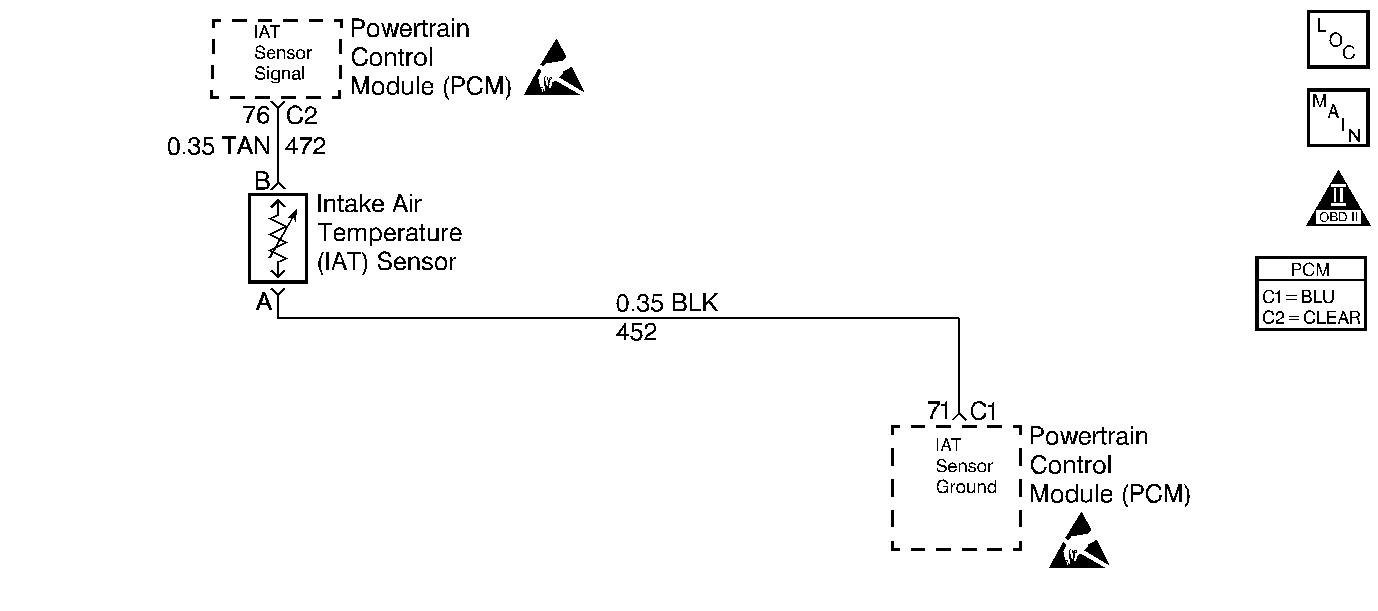
Circuit Description
The Intake Air Temperature (IAT) sensor is a thermistor, or variable resistor, that varies resistance based on temperature. Low temperature will result in a high signal voltage. If the IAT reading is -35°C (-31°F)or lower with the ECT sufficiently hotter than the IAT, the PCM sets DTC P1111.
Conditions for Setting the DTC
Test Conditions
| • | DTCs P0101, P0102, P0112, P0113, P0117, P0118, and P0502 not set. |
| • | Engine speed 500 RPM or greater for 10 seconds. |
| • | MAF input 60 grams per second or less. |
| • | Vehicle speed 50 MPH or less. |
| • | 5 seconds have passed with vehicle speed greater than 7 MPH since the engine was started. |
| • | Engine coolant temperature 0°C (32°F) or greater, or engine coolant temperature less than 0°C (32°F) and IAT at least 27°C (81°F) less than engine coolant temperature. |
Failure Condition
IAT -35°C (-31°F) or less with the above test conditions met.
Action Taken When the DTC Sets
| • | The Malfunction Indicator Lamp (MIL) will not illuminate. |
| • | No message will be displayed. |
Conditions for Clearing the DTC
| • | A History DTC will clear after forty consecutive warm-up cycles with no failures of any non-emission related diagnostic test. |
| • | A Last Test Failed (current) DTC will clear when the diagnostic runs and does not fail. |
| • | Use a scan tool to clear DTCs. |
| • | Interrupting PCM battery voltage may or may not clear DTCs. This practice is not recommended. Refer to Clearing Diagnostic Trouble Codes in PCM Description and Operation. |
Diagnostic Aids
If a faulty sensor is suspected refer to Temperature vs Resistance table.
If fault is not present perform Powertrain Ground Check and also review Failure Rec. to determine conditions under which and how long ago the DTC set.
Test Description
Number(s) below refer to the step number(s) on the Diagnostic Table.
-
If DTC P0111 is also set, diagnose it first because it may help to pinpoint a faulty IAT sensor.
-
Checking for intermittent circuit faults that may cause a high IAT reading.
Step | Action | Value(s) | Yes | No |
|---|---|---|---|---|
1 | Was the Powertrain On-Board Diagnostic (OBD) System Check performed? | -- | Go to A Powertrain On Board Diagnostic (OBD) System Check | |
Turn the key ON. Is DTC P0111 or P0113 also set? | -- | Go to DTCs that are set | ||
Was terminal contact repaired? | -- | Go to Powertrain Control Module Diagnosis for Verify Repair | ||
4 |
Was terminal contact repaired? | -- | Go to Powertrain Control Module Diagnosis for Verify Repair | |
5 |
Was a repair made to any circuit? | -- | Go to Powertrain Control Module Diagnosis for Verify Repair | Fault not present. Refer to Diagnostic Aids |
